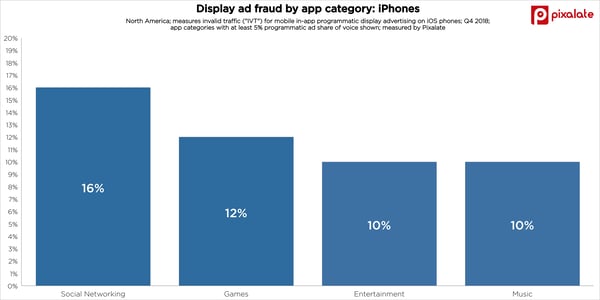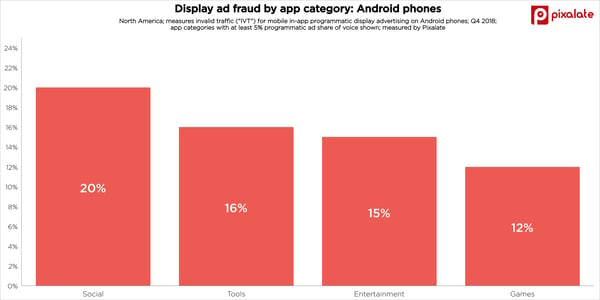
What are the latest mobile app fraud trends and invalid traffic (IVT) rates in programmatic advertising across different app categories? Pixalate analyzed the most recent mobile in-app ad fraud data to update you on the current state of app fraud and invalid traffic.
Download our most recent report for a comprehensive rundown of the latest trends in Mobile App Fraud, which is a nuanced topic.
Our mobile app fraud insight drills into the specific app categories with high IVT rates. On iOS phones (display advertising), we measured that Social Networking apps have the highest IVT rates.

Similar to iOS devices, Social apps also have the highest app fraud rates on Android phones for display advertising. And as our mobile ad fraud trends shows, Android devices typically have higher overall IVT rates.

Download our most recent report for the latest trends in Mobile App Fraud:
Still looking or more information about ad fraud?
For a high-level view of IVT in digital advertising, view our overall ad fraud trends.
For a high-level view of IVT in mobile advertising, view our mobile ad fraud trends.
*By entering your email address and clicking Subscribe, you are agreeing to our Terms of Use and Privacy Policy.
These Stories on Mobile
*By entering your email address and clicking Subscribe, you are agreeing to our Terms of Use and Privacy Policy.

Disclaimer: The content of this page reflects Pixalate’s opinions with respect to the factors that Pixalate believes can be useful to the digital media industry. Any proprietary data shared is grounded in Pixalate’s proprietary technology and analytics, which Pixalate is continuously evaluating and updating. Any references to outside sources should not be construed as endorsements. Pixalate’s opinions are just that - opinion, not facts or guarantees.
Per the MRC, “'Fraud' is not intended to represent fraud as defined in various laws, statutes and ordinances or as conventionally used in U.S. Court or other legal proceedings, but rather a custom definition strictly for advertising measurement purposes. Also per the MRC, “‘Invalid Traffic’ is defined generally as traffic that does not meet certain ad serving quality or completeness criteria, or otherwise does not represent legitimate ad traffic that should be included in measurement counts. Among the reasons why ad traffic may be deemed invalid is it is a result of non-human traffic (spiders, bots, etc.), or activity designed to produce fraudulent traffic.”

